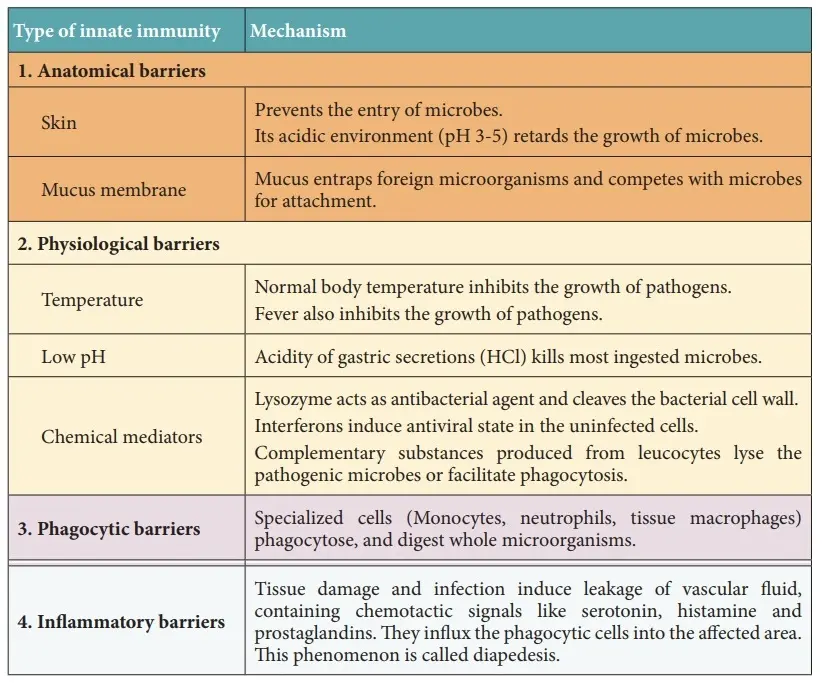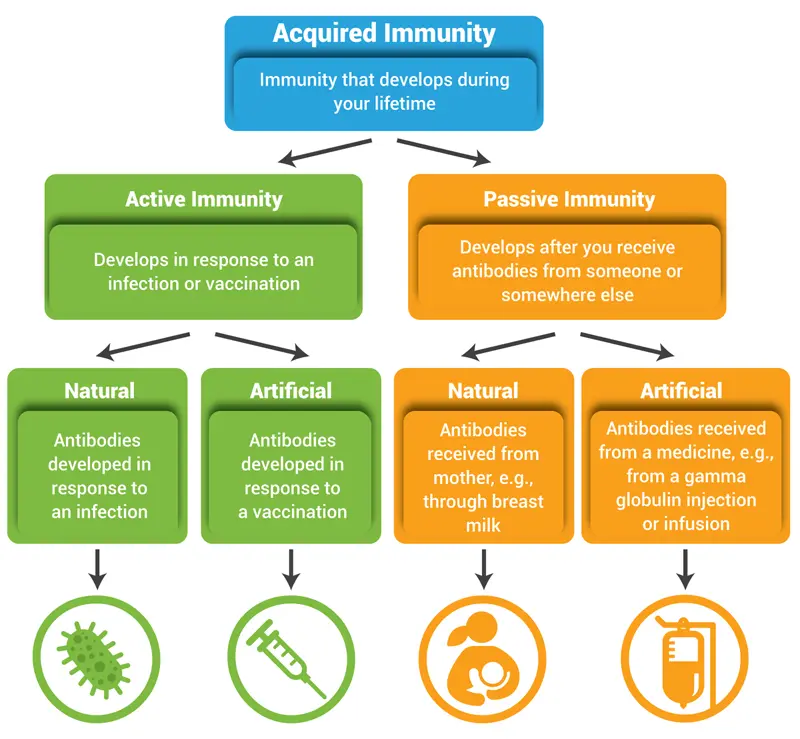The term ‘immunity’ is defined as resistance exhibited by the host against any foreign antigen including microorganisms. This resistance plays a major role for prevention of infectious diseases. Immunity may be two type i.e. innate or acquired.

I. INNATE IMMUNITY
It is the resistance which individual possesses by birth. It is by virtue of his genetic and constitutional make-up. It does not depend on prior contact with foreign antigen.
Innate immunity works against a variety of potentially infectious pathogens, the innate defensive systems are non-specific. It is also referred to as natural immunity or non-specific immunity.

A. Types of Innate Immunity
1. Species Immunity
It refers to the resistance to a pathogen, shown by all members of a particular species e.g. B. anthracis infects human beings but not chickens.
2. Racial Immunity
Within one species, different races may exhibit differences in susceptibility or resistance to infections. This is termed as racial immunity. In human beings, it is reported that American negroes are more susceptible than the white race to tuberculosis.
3. Individual Immunity
Resistance to infection varies with different individuals of same race and species. This is known as individual immunity.
B. Factors Influencing Innate Immunity
1. Age
The two extremes of life (foetus and old persons) carry higher susceptibility to various infections. In foetus, the immune system is immature whereas IMMUNITY in old age there is gradual waning of immune responses.
2. Hormones
Certain hormonal disorders such as diabetes mellitus and hypothyroidism enhance susceptibility to infections.
3. Nutrition
Malnutrition predisposes to bacterial infections. Both humoral and cell mediated immune responses are reduced in malnutrition.
C. Mechanisms of Innate Immunity
1. Epithelial Surfaces
(i) Skin
It not only acts as a mechanical barrier to microorganisms but also provides bactericidal secretions. The high concentration of salt in drying sweat, the sebaceous secretions and long chain fatty acids contribute to bactericidal activity. The skin may be freed of bacteria deposited on it (transient flora) but the bacterial flora normally present on skin (resident flora) is not easily removed even by washing and application of disinfectants. The resident bacterial flora of skin and mucous surfaces help to prevent colonisation by pathogens.
(ii) Respiratory tract
The inhaled particles are arrested in the nasal passages on the moist mucous membrane surfaces, The mucous secretions of respiratory tract act as a trapping mechanism and hair like cilia propels the particles towards the pharynx where it is swallowed or coughed out. The cough reflex acts as an important defence mechanism.
(iii) Intestinal tract
The mouth possesses saliva which has an inhibitory effect on many micro-organisms. Some bacteria may be swallowed and are destroyed by acidic pH of gastric juices. The normal bacterial flora of intestine further exert a protective effect by preventing colonisation of pathogenic bacteria.
(iv) Conjunctiva
Tears have a major role by flushing away bacteria and other dust particles. In addition, lysozyme present in tears has a bactericidal action.
(v) The Genitourinary tract
The flushing action of urine eliminates bacteria from the urethra. The acidic pH of vaginal secretions in female, due to the fermentation of glycogen by lactobacillus (normal flora), renders vagina free of many pathogens. In males, semen is believed to contain some antibacterial substances.
2. Antibacterial Substances
Besides specific antibody formation, there are number of nonspecific antibacterial substances present in blood and tissues. These substances are properdin, complement, lysozyme, betalysin, basic polypeptides (leukins from leucocytes, plakins from platelets) and interferons which Possess antiviral activity. The complement system plays an important role in the destruction of pathogenic microorganisms that invade the blood and tissues.
3. Cellular Factors
Once the infective agent has crossed the barrier epithelial surfaces, the tissue fectors come into play for defence.
When an infective agent invades tissue, an exudative inflammatory reaction occurs by accumulation of phagocytes at the site of infection Phagocytic cells ingest these organism and destroy them. barrier of factors come into play Phagocytic action can be divided into four stages :
i) Chemotaxis -Phagocytes reach the site of infection attracted by chemotactic substances.
(ii) Attachment-The infective agent gets attached ty Phagocytic membrane.
(iii) Ingestion- Phagocyte engulfs the infective materials into a vacuole (phagosome). The membrane of phagosomes fuses with a lysosome to form a Phagolysosome.
(iv) Intracellular killing
Most bacteria are destroyed in the Phagolysosome by hydrolytic enzymes of lysosomes. However, Some bacteria (M. tuberculosis, M. leprae) resist this type of killing and canmultiply wi Phagolysosome and thus produce disease.
4. Inflammation
Inflammation occurs as a result of tissue injury or irritation, initiated by the entry of pathogens or irritants. It is an important non-specific defence mechanism. Inflammation leads to vasodilation, increased vascular permeability and cellular infiltration. Microorganisms are phagocytosed and destroyed. Due to increased vascular permeability there is an outpouring of plasma which help to dilute the toxic products present. A fibrin barrier is laid to wall off the site of infection.
5. Fever
A rise in temperature following infection is natural defence mechanism. It destroys the infecting organisms. Fever also stimulates the production of interferon which helps recovery from viral infections.
6. Acute phase proteins
Following infection or injury, there is a sudden increase in plasma concentrations of certain proteins, collectively called acute phase proteins. These include C reactive protein (CRP) and many others.
II. ACQUIRED IMMUNITY
The resistance acquired by an individual during life is known as acquired immunity. It is two types, active and passive.

A. Active Immunity
Active Immunity is subdivided into Natural and Artificial.
Natural—Through clinical or subclinical infection
Artificial—Induced by vaccination
Note: Active immunity develops after a latent period which is required for immune system to act but once developed, the active immunity is long lasting.
Mechanism of active immunity
Active immune response stimulates both humoral and cell mediated immunity usually in parallel.
(i) Humoral immunity
It is antibody mediated immunity, It depends on the synthesis of antibodies by plasma cells. These cells produce specific circulating antibody which combines specifically with the antigens and modify their activity. This modified activity may be in the form of lysis of antigen molecules; their toxin may be neutralised, or in the form of removal of antigen by phagocytosis.
(ii) Cell mediated immunity (CMD)
It depends on T-lymphocytes developed against certain antigens. The cell mediated immunity by sensitised T-lymphocytes is important in resistance to chronic bacterial infections. In these chronic infections, organisms can multiply and survive in phagolysosome i.e. intracellular parasitism (tuberculosis, leprosy) and in viral infections (Herpes simplex).
Types of active immunity
(i) Natural active immunity
It is acquired by natural subclinical or clinical infections. Such immunity is long lasting. Persons recovering from smallpox infection develop natural active immunity.
(ii) Artificial active immunity
It is produced by vaccination. The vaccines are prepared from live, attenuated or Killed microorganisms, or their antigens cz toxoids. In killed vaccines the organisms are killed by heat, formalin, phenol and alcohol. These are preserved in phenol, N-merthiolate and alcohol. Toxoids are prepared from bacterial exotoxins inactivated by formalin (formol toxoid) or by alum (alum Precipitated toxoid-APT). Toxoids are immunogenic but not toxigenic.
B. Passive Immunity
Passive immunity is subdivided into two types :Natural and Artificial.
Natural- Through transplacental maternal IgG antibodies.
Artificial- Through antiserum injection.
‘Passive immunity is induced in an individual by preformed antibodies (generally in the form of antiserum) against infective agent or toxin. The immune system has no active role in passive immunity. Protection starts immediately after transfer of immune serum. There is no latent period as present in active immunity (Table 9.1).
Passive immunity is short lasting but is useful when immunity is required immediately. Passive immunity is again of two types: natural and artificial.
i)Natural Passive immunity
It is transferred from the mother to foetus or infant. Transfer of maternal antibodies to foetus transplacentally and to infant through milk (colostrum) protects them till their own immune system matures to function.
ii) Artificial Passive immunity
It is through parenteral administration of antibodies. The agents used for artificial passive immunity are hyperimmune sera of animal or human origin, convalescent sera and pooled human gammaglobulin. The oldest method is to employ horse hyperimmune sera. Antitetanus serum (ATS) is prepared by injecting a series of doses of tetanus toxoid to horses, and bleeding them to separate the serum. As ATS is a foreign protein, it is liable to cause hypersensitivity reactions. To eliminate these complications, human ATS is employed.
This is prepared by hyperimmunisation of human volunteers with tetanus toxoid. Protection with human ATS lasts longer as there is no immune elimination of the human globulins.
Convalescent sera (sera of patients recovering from infectious diseases) contain high levels of specific antibody and therefore is employed for passive immunisation against measles and rubella. Sera of healthy adults can be Pooled and is used for Passive immunisation against common infectious diseases prevalent in the region. Pooled human gammaglobulin are used for Passive immunisation against some viral infections e.g. hepatitis A. It has to be ensured that all preparations from human sera should be free from the risk of infections with hepatitis B, hepatitis C, HIV and other viruses.
Uses of Passive Immunization
(i) To provide immediate short term Protection in a nonimmune host, faced with the threat of a serious infection.
(ii) For suppression of active immunity which may be injurious. Example is to use Rh immunoglobulins during delivery to prevent immune response to Rh factor in Rh negative mothers with Rh positive babies.
(iii) For treatment of serious infections.
Difference between active & passive immunity

II. MISCELLANEOUS IMMUNITY
A. Combined Immunisation
A combination of active and passive immunisation is employed simultaneously which is know” as combined immunisation. Passive immunity Provides the protection necessary till the active immunity becomes effective.
B. Adoptive Immunity
Injection of immunologically competent lymphocytes is known as adoptive immunity. Instead of whole lymphocytes, an extract imminologically competent lymphocytes can be used. This is being attempted in of lepromatous leprosy. Such lymphocytes collectively known as transfer factor.
C. Local Immunity
Natural infection or live viral vaccine administered orally or intranasally provides local immunity at the site of entry such as gut mucosa and nasal mucosa respectively. A special class of immunoglobulins (IgA) plays an important role in local immunity. IgA (secretory) is produced locally by plasma cells
D. Herd Immunity
It refers to the overall resistance in a community. When herd immunity is low, chances of epidemics increase on introduction of a suitable pathogen.

Comments are closed